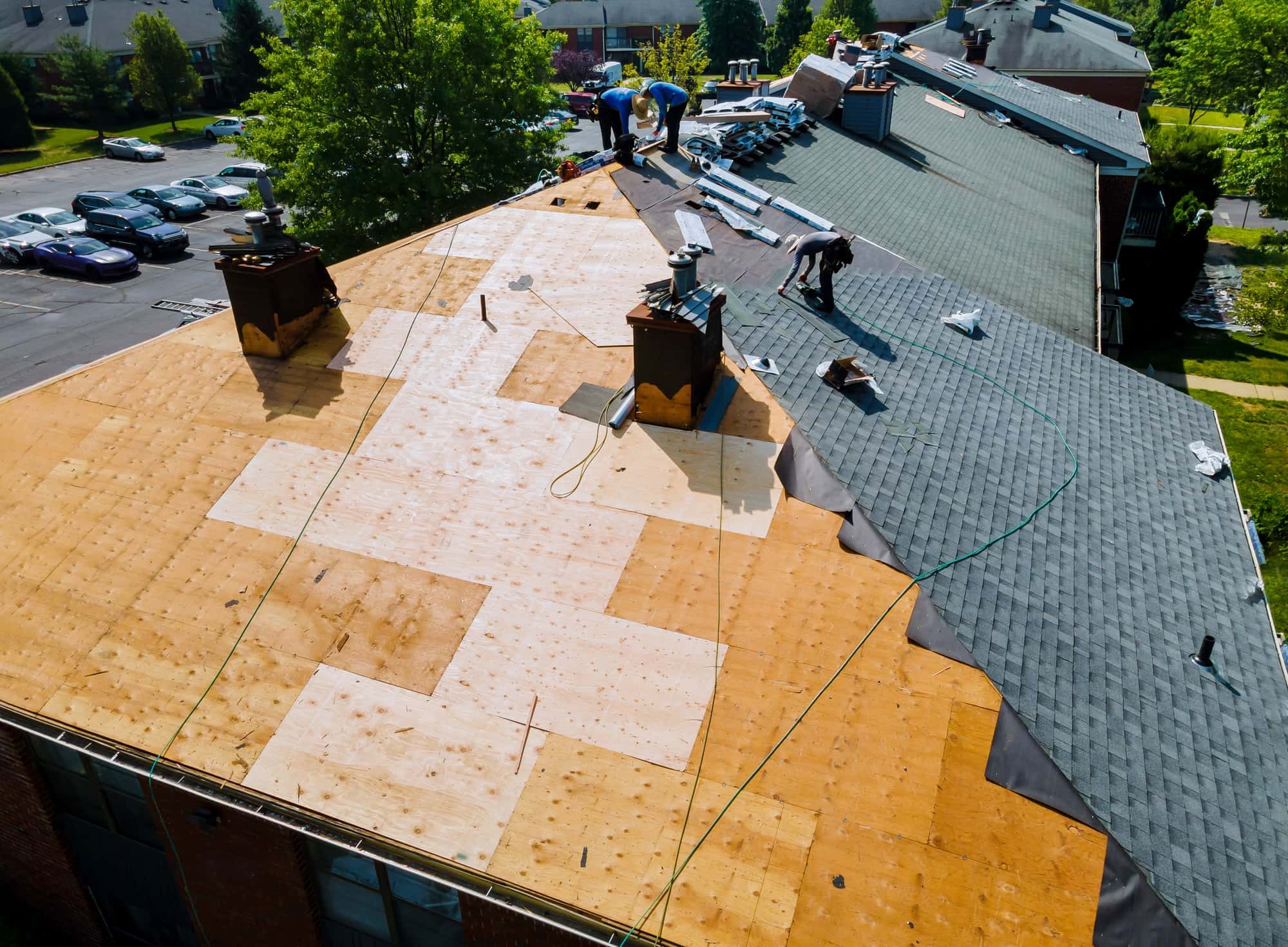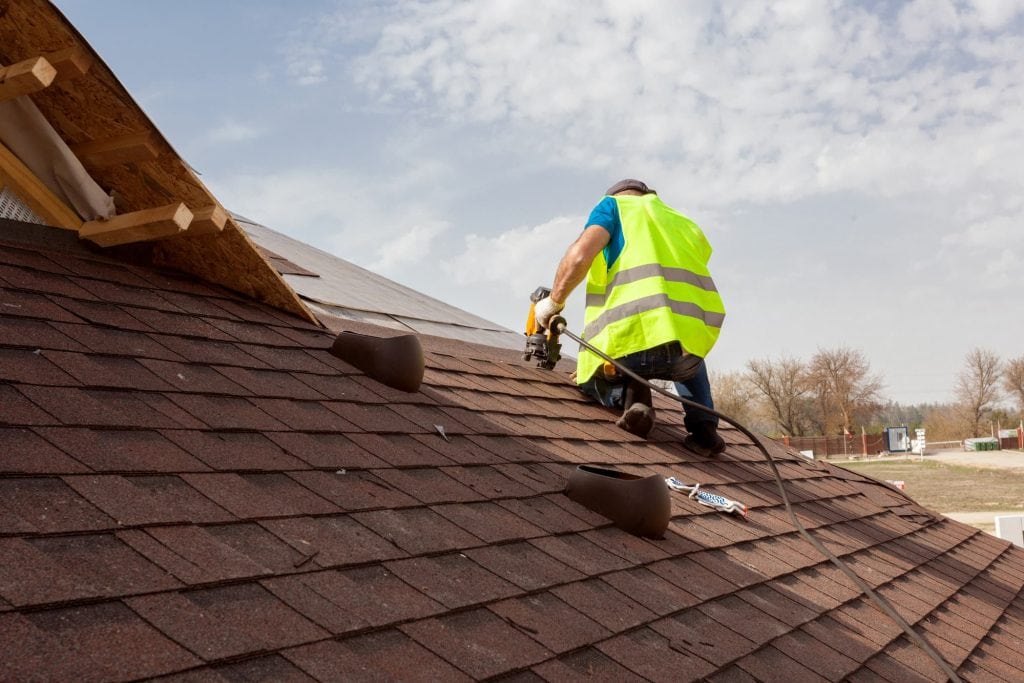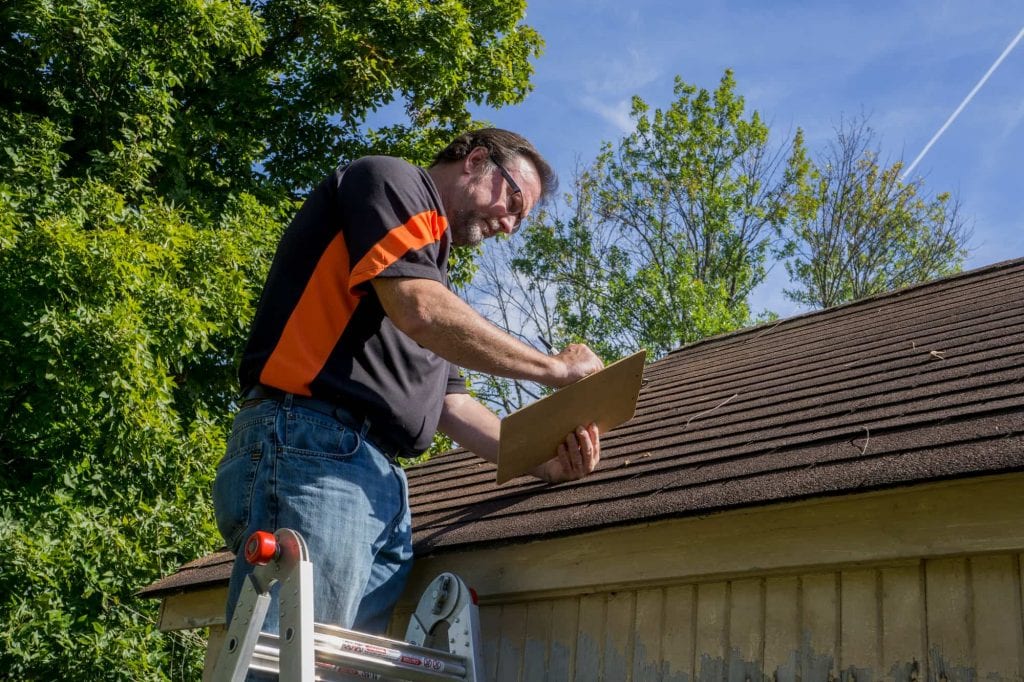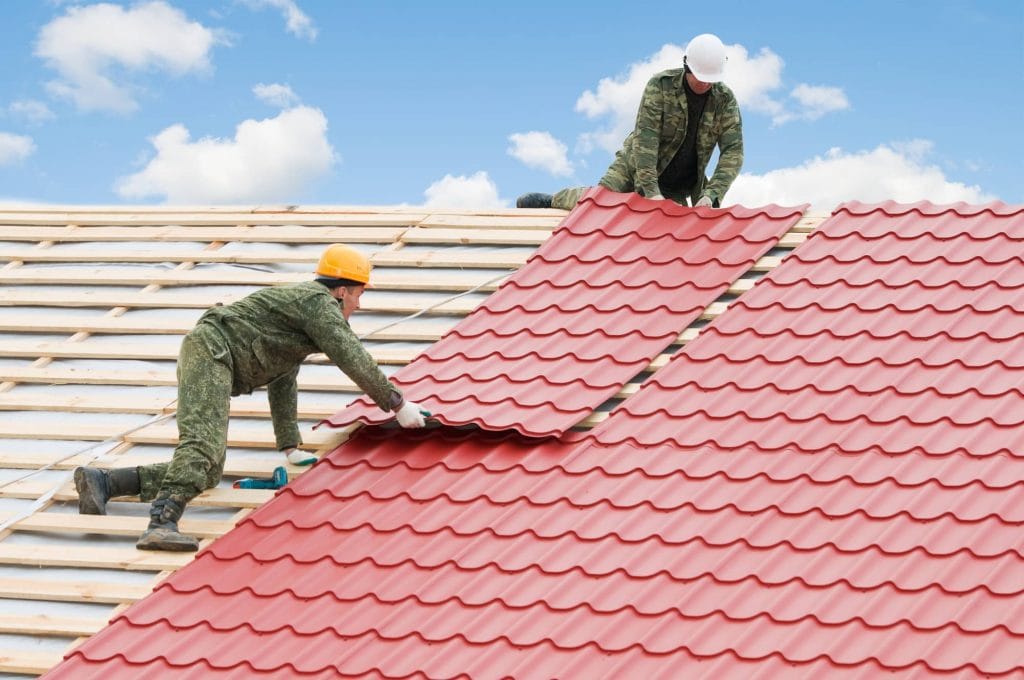Your roof is a significant part of your home, offering protection, energy efficiency, and increased curb appeal. But like all aspects of a home, it wears out over time, requiring repairs or even a complete replacement.
Roof replacement is a considerable investment, so it’s essential to understand the potential costs involved.
In this guide, we’ll explore the key factors that influence the cost of roof replacement. If you’re contemplating roof replacement or simply want to know more about home improvements, keep reading to learn more.
The Factors That Affect Roof Replacement Costs
The cost of replacing a roof can vary widely, depending on several factors, from the type of roofing materials to the size and complexity of the roof. Let’s dive into these determinants to help you get a clearer picture of your potential investment.
Type of Roofing Material
The roofing material is one of the most significant contributors to the cost of roof replacement. Basic asphalt shingles are a common type of roofing material and an affordable option, with the average roof replacement cost for an asphalt shingle roof being lower than most other materials.
Architectural shingles, a type of asphalt shingle, is a roof material that offers more durability but at a higher price. Metal roofing, such as galvanized steel, is a more expensive roofing material but offers longevity and energy efficiency.
Premium materials like slate or copper roofing come at a higher price but provide a distinctive aesthetic and exceptional durability. Composite shingles and wood shakes, such as cedar shake shingles, offer a middle-ground option, balancing cost, durability, and aesthetic appeal.
Synthetic & Recycled Roofing Materials
Apart from the standard materials mentioned, synthetic roofing materials are also gaining popularity. These include rubber, plastic, and polymer roofing, designed to mimic natural materials like wood or slate but at a lower cost.
Using recycled materials in their production also makes them an environmentally-friendly choice. However, as these are relatively new products, their long-term durability is still being evaluated.
Roof Size and Complexity
The size of your roof, measured in roofing squares (a roofing square equals 100 square feet), directly influences the cost of materials and labor. A larger roof requires more materials and more time for installation, leading to higher roof costs.
The complexity of the roof also plays a significant role. A complex roof with many angles, the presence of skylights, or chimneys will require more labor and possibly special materials, increasing the roof replacement cost.
Consequently, if a roof has multiple levels or unusual shapes or requires the removal of old roofing materials, these factors will likely increase the costs. The existing roof’s condition can also impact the cost; if the underlying structure is damaged and requires repair or replacement, this will add to the overall expenditure.
Roof Pitch
The pitch, or steepness, of your roof affects the roof replacement cost. Flat roofs or roofs with a low slope are easier and safer for the roofing contractor to work on, hence less costly. On the other hand, steep roofs require additional safety measures and specialized skills, leading to higher labor costs.
Very flat roofs can present their own challenges as they may require additional layers of material to prevent water leakage. This need for additional waterproofing can also add to the overall costs of the roof replacement.
Geographic Location
Your location, such as living in North Carolina or another region, can influence the roof replacement cost. This variance results from differences in the cost of living, local labor rates, and regional material costs.
For example, in regions prone to extreme weather events, additional building codes might need to be adhered to for roofing projects. This could increase the overall project cost due to the need for specific materials or extra labor for installation.
Labor and Installation Costs
Labor costs make up a significant part of your roof replacement cost. Depending on the roofing company, labor costs can vary based on the project’s complexity, the type of roofing material, and the roof’s size and pitch. Remember to account for the installation costs of additional materials like water barriers and pipe boots for a more accurate estimate.
The cost might increase if the contractor has to work around power lines, trees, or other obstructions that can slow down the process or pose safety risks. An experienced roofing contractor can help you understand all these nuances in labor and installation costs.
Roof Accessibility
Suppose your roof is hard to access on a two-story house with no direct access; this can increase labor costs due to the extra time and effort required to move materials to and from the roof.
This difficulty in access can be even more significant if your home is located on a hill or other challenging terrain, where special equipment might be needed to deliver materials and perform the work, thereby further driving up costs.
Structural Repairs
If your roof deck or supporting structures have suffered water or other damage, you’ll need to account for the cost of structural repairs. These could include replacing the roof deck or minor repairs to areas affected by water or storm damage.
Structural repairs may involve the addition of new support beams or the reinforcement of existing ones. In severe cases, it may be necessary to replace sections of the structure entirely. These changes can significantly increase the overall cost of the roof replacement.
Roof Warranties
Roofs come with two types of warranties:
- A manufacturer warranty, which covers the roofing materials.
- A workmanship warranty, which covers installation errors.
Premium roofing materials often come with extended warranties, which can increase their upfront cost but provide peace of mind in the long term.
For instance, a transferable warranty can be a great selling point if you plan to sell your home in the future, as it adds an extra layer of protection and assurance for potential buyers.
Remember, roof replacement costs are a long-term investment that can enhance your home’s curb appeal, increase its resale value, and improve comfort and energy efficiency.
Estimating the Average Cost of Roof Replacement
Estimating the average roof replacement cost involves factoring in various considerations. Industry standards, national averages, regional price variations, and specific breakdowns based on material and size all play crucial roles. To fully understand these factors, let’s delve into each one.
Industry Standards for Calculating Roof Replacement Costs
In the roofing industry, costs are usually calculated per roofing square, which is a 10×10 foot area equal to 100 square feet. This standard measurement allows roofing professionals to provide accurate estimate services regardless of the type of roofing material used.
When roofing contractors create estimates, they often break down the costs into two main components: material and labor costs. Material costs vary depending on the type of roofing material you choose. For example, asphalt shingles, the most common roofing material, have a lower material cost than premium materials such as slate tiles or copper tiles.
On the other hand, labor costs can fluctuate based on a few factors, such as the roof’s complexity, the pitch’s steepness, and the geographic location. More complex roofing installations typically require more skilled workers and time, leading to higher labor costs.
However, remember that the estimated cost of a roofing job is not only about square footage. Factors such as roof pitch, the number of layers of shingles that need to be removed, and whether there are any structural repairs required can also impact the total cost.
National Averages and Regional Price Variations
On a national level, the average roof replacement cost ranges between $5,000 and $10,000 as of the time of writing. This price range is for a typical one-story house with a roof size of about 1,700 to 2,000 square feet.
However, these figures can vary greatly depending on regional factors. For instance, your area’s cost of living and local labor rates can significantly affect the roof replacement price. If you’re located in a region with a higher cost of living, like certain parts of North Carolina, you might expect to pay more for roof replacement than in areas where the cost of living is lower.
Moreover, material costs can also vary based on location due to transportation and supply and demand factors. As such, it’s beneficial to request quotes from several local roofing contractors to get an accurate estimate for your location.
There may also be local or state regulations regarding roof replacement that could influence the cost. This could include specific permitting fees, inspection costs, or even requirements for specific materials or construction methods.
Roof Replacement Cost Breakdowns Based on Material and Size
The roof replacement cost can vary significantly based on the type of material used and the roof size. Below are some examples to give you a clearer idea of how these factors affect the total cost.
For an average-sized roof (about 1,700 square feet), a basic asphalt shingle roof replacement could range from $3,400 to $5,000. This cost includes both the materials and the labor.
A metal roof of the same size could cost between $8,500 and $14,500. While metal roofing is more expensive than asphalt, it offers more durability and can last much longer, making it a worthwhile long-term investment.
Premium materials like slate or copper roofing could range from $17,000 to $30,000 for an average-sized roof. These durable and visually striking materials add significant curb appeal to your home.
Remember, these are just averages. The exact cost can vary based on roof complexity, location, and any necessary repairs or additional materials.
Note, however, that these cost estimates are merely averages. Additional costs may arise due to the unique aspects of your specific roof replacement project, including the need for structural repairs, accessibility issues, and regional price variations.
In conclusion, calculating the roof replacement cost requires careful consideration of various factors. By understanding these factors and consulting with roofing professionals, you can make informed decisions about your roof replacement project.
Cost-Effective Roof Replacement Options
When faced with a roof replacement project, homeowners often look for cost-effective solutions that will maintain their homes’ durability and aesthetic appeal. Fortunately, several ways exist to reduce roof replacement costs without compromising quality. You can make the roof replacement process more affordable by exploring alternative roofing materials, maintaining your roof regularly, taking advantage of financing options, and employing cost-saving strategies.
Alternative Roofing Materials Offering Value for Money
If the cost of traditional roofing materials is too high, consider alternative options that offer good value for money. For example, asphalt shingles are popular due to their affordability and durability. Among them, three-tab shingles are the most affordable option, while dimensional shingles, also known as architectural shingles, offer a more stylish appearance with slightly higher durability.
Metal roofing, particularly galvanized steel, offers excellent durability and energy efficiency at a relatively affordable price. Steel shingles, for instance, can last up to 60 years and help to keep your attic space cool, reducing energy bills.
Composite shingles, made of several materials, can mimic the look of more expensive roofing materials like wood shakes or slate tiles at a fraction of the cost. They are also lightweight, reducing the strain on your home’s structure, and come in various styles and colors to suit any home design.
However, when considering alternative materials, it’s important to understand that the cheaper upfront cost may not necessarily translate into long-term savings. Lower-cost materials might not last as long or perform as well as more premium options, resulting in additional maintenance or replacement costs down the line.
Regular Roof Maintenance for Longevity
Regular roof maintenance is one of the most cost-effective ways to extend your roof’s lifespan. Keeping your roof in good condition can postpone the need for a complete replacement. This includes regular inspections, particularly after storms, to identify and fix minor repairs such as replacing missing or damaged shingles, water damage, or pipe boots.
Maintaining proper air circulation in your attic can also prevent heat and moisture build-up, which can cause your roofing materials to deteriorate faster. Cleaning your gutters regularly to prevent water back-ups is another maintenance task that can help preserve your roof.
Proactive roof maintenance will help you spot and address minor issues before they become costly repairs and ensure that you are making the most out of your existing roof before deciding to replace it.
Financing Options and Incentives for Roof Replacement
Several financing options are available if the roof replacement cost is too high to pay out of pocket. A home equity or personal loan can provide the funds needed for a roof replacement. Be sure to compare loan offers from different lenders to get the best rates.
In addition, some energy-efficient roofing materials may qualify for tax credits or rebates, which can help offset the cost. Check with your local government or utility company to see if any incentives are available in your area.
For example, some lenders offer home improvement loans specifically for projects like roof replacements. Additionally, some roofing contractors offer financing options, which can be a convenient choice since you’re dealing directly with the service provider.
Cost-Saving Tips and Strategies for Homeowners
You can also employ various strategies to save on roof replacement costs. One is to get estimates from several roofing contractors to ensure you are getting a competitive price. Be sure to ask for a breakdown of costs to understand what you are paying for.
Opting for an off-peak season for your roof replacement project can also lead to savings, as roofing contractors often offer discounts during slower periods. Additionally, properly insuring your home can help cover the costs if a covered event like a hail storm damages your roof.
Lastly, consider a partial replacement if only part of your roof is damaged. This can be a viable option if the rest of your roof is in good condition and the color and style of the new shingles match the old ones.
Another way to save money is to plan ahead. If you know your roof will need to be replaced in a few years, start setting aside money now to avoid financing the entire cost. Planning also allows you to maximize sales or discounts on materials.
Hiring Professionals for Roof Replacement
Choosing the right roofing contractor is crucial to ensuring the success of your roof replacement project. With a licensed and insured professional, you are more likely to receive high-quality workmanship that adheres to safety standards, meets your expectations, and fits within your budget.
Here, we delve into the process of hiring professionals, from the importance of working with licensed contractors to negotiating prices and understanding contract terms.
Importance of Hiring Licensed and Insured Roofing Contractors
Not all roofing contractors offer the same quality of service, and the one you choose can significantly impact your roofing project’s overall cost and success. Hiring a licensed and insured roofing contractor is essential. These professionals adhere to local and national regulations, ensuring your roof is installed or repaired according to industry standards.
An insured contractor protects you from potential liability. For example, if a worker is injured on your property, their company’s insurance should cover their medical expenses. Likewise, if there’s accidental damage to your home during the roof replacement, their insurance will cover the repairs. Ask for proof of insurance when vetting potential contractors.
Another important consideration is the warranty offered by roofing professionals. A solid warranty provides peace of mind, covering certain repairs or replacements if the new roof fails prematurely. Manufacturer warranties cover the roofing materials, while workmanship warranties the contractor offers cover installation errors.
Licensed contractors are likely to be up-to-date with the latest industry standards, best practices, and technological advances. This can translate to a more efficient and effective roof replacement, reducing potential problems.
Obtaining and Comparing Quotes
Roof replacement is a significant investment, so getting estimates from several roofing contractors is vital to ensure you’re getting a fair and competitive price. These quotes should include labor rates, material costs, and any additional materials or services that may be required, such as a roof deck inspection or replacement water barriers.
When comparing quotes, don’t simply go for the cheapest option. A low bid might indicate substandard materials or workmanship. Instead, compare the cost of materials, labor, and the scope of work in each estimate to make an informed decision.
Also, remember that the most accurate quotes come from in-person inspections. A professional roofing contractor who takes the time to inspect your roof in person will be better equipped to provide a precise estimate, reducing the likelihood of unexpected costs or complications during the project.
Checking References and Reviews
In addition to obtaining quotes, check each contractor’s references and online reviews. Past clients can provide valuable insights into a contractor’s professionalism, reliability, and quality of work. Look for contractors with a history of positive feedback and successful roof installations.
Online platforms like the Better Business Bureau, Yelp, and Google Reviews can provide information about potential contractors. Look out for specific commendations or complaints about things that matter to you, like punctuality, cleanliness, and communication.
Negotiating Prices and Understanding Contract Terms
Once you’ve narrowed your list, it’s time to negotiate the price. Some roofing contractors might be willing to lower their prices or offer better materials for the same cost. Remember, the goal is to get the best value for your money, not just the lowest price.
Before signing any contract, make sure you fully understand the terms. This includes the scope of work, cost, payment schedule, estimated start and completion dates, and details about the warranty. If there are terms you don’t understand or agree with, don’t hesitate to ask for clarification or negotiate changes.
Key Takeaways
Roof replacement is a substantial home improvement venture influenced by numerous elements, including the chosen roofing material, roof size and complexity, pitch, geographic location, structural repairs, labor costs, and warranty choices.
The selection plays a crucial role in cost, from affordable asphalt shingles to premium materials like slate or metal. The scale and design of the roof, location-based variables, potential structural repairs, labor, and warranty terms also significantly impact the total expenditure.
Affordable and durable roof replacement options exist, helping homeowners manage costs effectively. Alternatives such as architectural shingles or galvanized steel and regular roof maintenance can prolong the roof’s life and defer a full replacement.
Various financing choices and incentives can alleviate the financial burden. Additional cost-saving strategies include scheduling installations during off-peak seasons and negotiating with contractors.
The significance of hiring professional, licensed, and insured roofing contractors can’t be understated. These experts adhere to industry standards and local regulations and carry insurance to protect homeowners from potential liability. To secure a fair deal, homeowners should get multiple quotes, check references, read online reviews, and comprehend contract terms.
Remember to engage a real estate professional who can provide insightful advice. They may be able to connect you with a trustworthy and experienced roofing contractor. And, if you’re planning on moving after replacing your roof, visit eXp Realty to perform a custom home search or sign up for alerts when new properties hit the market.
FAQs: Roof Replacement
As we navigate the complex roof replacement process, it’s natural to have some questions. Here are some commonly asked queries and their answers to help you better understand this significant home improvement task.
How much will I save if I do my own roof?
While DIY roof replacement might seem like a way to save money, it’s important to remember that this project requires specific skills and tools. A lack of experience can lead to mistakes, potentially causing more expenses in the long run.
Additionally, roofing work can be dangerous without the proper safety equipment and training. Hiring a professional roofing contractor is usually more cost-effective and ensures a high-quality result.
What is the cheapest roof to replace?
Asphalt shingles are the most affordable roofing material, particularly the basic 3-tab shingles. These are commonly used due to their cost-effectiveness and relatively simple installation process. However, remember that cheaper materials may only last briefly or offer the same performance and aesthetics as more expensive options.
What do most roofers charge per square?
Roofing contractors typically charge per roofing square, 10×10 foot area, or 100 square feet. The cost per square can vary widely depending on roofing material type, installation complexity, and local labor rates. For asphalt shingle roofing, you should pay between $350 and $550 per square.
How often do you need to replace a roof?
The lifespan of a roof depends on several factors, including the type of roofing material, the quality of the installation, and how well the roof is maintained. For instance, an asphalt shingle roof can last 15 to 25 years, while metal roofs can last 40 or more. Inspecting your roof regularly is recommended to identify any issues that might require repair or replacement.
What time of year is the cheapest to replace a roof?
The roofing industry often sees less demand during late fall and winter, so you can negotiate a better price. However, weather conditions can complicate roofing work, so there are better times for a replacement. The ideal time to replace your roof depends on your circumstances and the local climate.
How long does a new roof last?
The lifespan of a new roof varies based on the material used, the quality of the installation, and the climate and weather conditions in your area. On average, an asphalt shingle roof might last 15 to 25 years, a wood shake roof around 30 years, and a metal or tile roof can last 50 years or more. Regular maintenance and inspections can help extend the lifespan of your roof.










